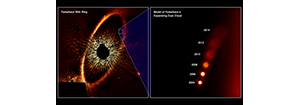Revealing Fomalhaut b's True Nature

Assistant Astronomer Andras Gaspar and Professor George Rieke propose a solution to the decade old mystery of the first directly imaged exoplanet, Fomalhaut b, in an article recently published in the Publications of the National Academy of Sciences. First discovered in 2008 in images taken with the Hubble Space Telescope (HST) in 2004 and 2006, Fomalhaut b has always been an enigmatic object within the group of roughly two dozen directly imaged exoplanets. Despite being observed multiple times in the optical, it remains undetected at infrared wavelengths, contrary to expectations for a massive planet. In addition, its eccentric orbit crosses the debris ring around the star, yet the ring does not show the perturbations expected from interaction with a massive planet.

For Public
Public events include our Monday Night Lecture Series, world-reknowned Astronomy Camp and Mt Lemmon Sky Center.

For Students
A good place to start if you want to become an undergrad major or grad student, or need to find our schedule of classes.

For Scientists
Find telescopes and instruments, telescope time applications, staff and mountain contacts, and faculty and staff scientific interests.




